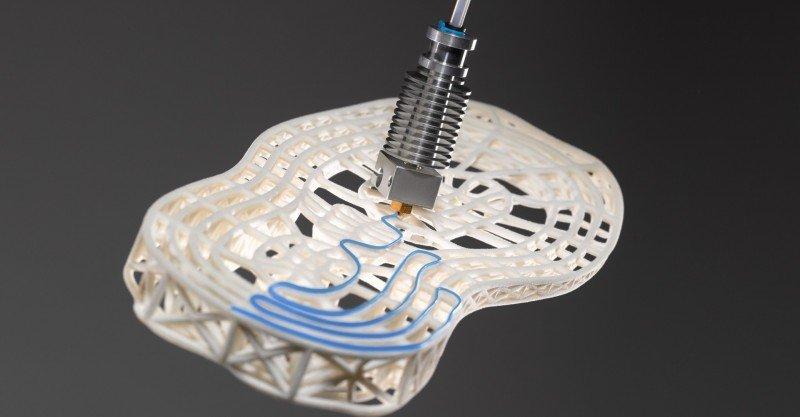- Automated application in shoe manufacturing and electronics assembly
- Simple processing with accurate dosing
- No loss of quality
- Recycling feasible with thermoplastic adhesives
The manufacture of casual shoes, sneakers and sports shoes is a labor-intensive process involving numerous production steps. Many of these are still performed manually, for example the application of the adhesive, which is usually still done with a brush. When bonding the upper material and the outsole, it is important to ensure exact dosing and very precise application at the correct location so that the sole does not come off and visibly excessive application is avoided. Hot-melt adhesives based on Covestro’s Desmomelt® U thermoplastic raw material powder can now be applied automatically and in precise doses using digital printing.
Polyurethane dispersions have proven their worth in adhesives for manual shoe production. But attempts to automate manual application with robot-assisted processes have not been successful to date.
Digital printing, on the other hand, enables shoe manufacturers to automate adhesive application to the highest level of precision. This is significantly more effective and faster, as processing steps can be saved and the precise digital application creates less waste that would need to be disposed of. The adhesive joints exhibit the same high quality as with the previous manual production.
Digital adhesive application on smartphone displays
Manufacturers of smartphones and other electronic devices must produce as leanly, cost-efficiently and automatically as possible to remain competitive. In addition, consumer purchasing decisions are increasingly influenced by whether products can be recycled at the end of their useful life. Covestro enables electronics manufacturers to efficiently apply hot-melt adhesives based on its Desmomelt® U polyurethane adhesive raw material in a digital process. In the case of thermoplastic adhesives, end-of-life recycling can also be facilitated.
Covestro will present both developments during Digital Expo 2021, September 14-16. For more explanations, join the webinar with experts Dr. Dirk Achten and Dr. Ann-Christin Bijlard-Jung on September 14, starting at 5 p.m. CEST.
The application of adhesives to smartphone displays is often a time-consuming part of the manufacturing process. For example, adhesive foils are applied that must be precisely cut beforehand. An analogous process is based on latently reactive 2-component hot-melt films, which are still crosslinked after the joining process to create a particularly strong adhesive bond between the components. Due to the strong bond, however, disassembly at the end of the service life is often difficult.
Efficient assembly
Hot-melt adhesives based on Desmomelt® U can be applied exactly where they are needed using digital printing. Automation of adhesive application reduces the number of processing steps required. Nevertheless, complex, CAD-based adhesive bonding paths are possible. After usage of the smartphone, it is possible to disassemble components in a temperature-controlled manner if only thermoplastic raw materials have been used. If particularly strong adhesive bonds are required, then the digital application of latent 2C reactive hot-melt adhesives based on Desmomelt® U and Desmodur® crosslinkers is also possible.
The new adhesive raw materials based on Desmomelt® U are aliphatic and thus protected against yellowing. They combine the advantages of water-based adhesives, for example high molecular weight, environmental compatibility and performance, with the easy processability of hot-melt adhesives. The open time can be adapted to customers‘ wishes, which makes processing even more flexible.
The project is part of a comprehensive program with which Covestro is systematically driving forward digitalization. One of the three pillars of the "Digital@Covestro" program is the development of new business models and digital technical services. One focus area is a more efficient production at customers and the digitization of entire value chains. The two other pillars of the program are focused on digital operating processes in the company’s own production and the development and use of digital chemical trading platforms.
Forward-looking statements
This news release may contain forward-looking statements based on current assumptions and forecasts made by Covestro AG. Various known and unknown risks, uncertainties and other factors could lead to material differences between the actual future results, financial situation, development or performance of the company and the estimates given here. These factors include those discussed in Covestro’s public reports which are available at www.covestro.com. The company assumes no liability whatsoever to update these forward-looking statements or to conform them to future events or developments.
With 2020 sales of EUR 10.7 billion, Covestro is among the world’s leading polymer companies. Business activities are focused on the manufacture of high-tech polymer materials and the development of innovative, sustainable solutions for products used in many areas of daily life. In doing so, Covestro is fully committed to the circular economy. The main industries served are the automotive and transportation industries, construction, furniture and wood processing, as well as electrical, electronics, and household appliances industries. Other sectors include sports and leisure, cosmetics, health and the chemical industry itself. At the end of 2020, Covestro has 33 production sites worldwide and employs approximately 16,500 people (calculated as full-time equivalents).
Covestro AG
Friedrich-Ebert-Straße 350
51373 Leverkusen
Telefon: +49 (214) 60092000
http://www.covestro.com/
Externe Kommunikation / Fachpresse
Telefon: +49 (214) 30-25363
Fax: +49 (214) 30-66426
E-Mail: Frank.Rothbarth@covestro.com
![]()

